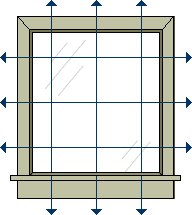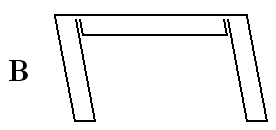Window Treatments
So this topic is a little bit of a doozy and usually boggles many a mind. I hope this post will help to clarify "window treatments" for some. So where to start...
How do I measure?
Well you have two options,
1) the centre can put you in touch with an installer who will also do the measurements or
2) you can measure yourself
here is how it works.
Inside mount
You should measure all three widths of the window, top, middle and base. This is in case the window is not the same width all the way down and will help avoid the window treatment scraping the casing in areas that are more narrow . You will order the smallest of the three measurements

FYI, manufacturers will take off deductions on inside mount measurements ("tight" measurements) unless we specify not to. I do not recommend ordering exact for inside as something always goes wrong.
An installer will measure inside mount blinds with deductions in mind.
Deductions are usually and 1/8" of an inch off of each side, so a total of 1/4" usually
Please measure to the 8th as if you measure to the 16th I will just have to convert back to 8ths.
Please measure to the 8th as if you measure to the 16th I will just have to convert back to 8ths.
Outside Mount
Depending on what you want to cover will determine your measurements, whether you want to only cover the glass and leave the casing visible or cover the total casing.
Also, when measuring take into account if you are not mounting onto casing that you need to know the head rail height so you can add this to your overall height.
No deductions will be taken from outside mount blinds

Bay Windows
| |||||
Budget?
- Depending on your budget may determine the window treatments you choose
What is the application?
- The type of treatment you choose will usually be determined by the application,
here are some suggestions.
Bedrooms where you do not want any light
Cellular/Honeycomb Shade
- Cellular/Honeycomb shades. Not only will you get the tightest fit in the window and the least amount of "halo" light but they are also very clean and simple in looks.
- Cellular/Honeycomb shades also have the most features available. You can do top down, bottom up
- Cordless
- Top down, bottom up cordless
- veriglide (only one or two suppliers do this)
dual shade ( duo lite, day/night) - This is usually a sheer or semi-opaque (light filtering) window treatment on top and a semi-opaque ( light filtering) or opaque ( room darkening) treatment on the bottom. Keep in mind this version you will be paying for two window treatments in one window
Faux and Real Wood
- Another option for bedrooms that is more reasonable is the real or faux wood blinds. These can look lovely depending on the colour and application. For bedrooms most manufacturers now have an option of "no router holes" for their wood blinds. This means, there will be no holes in the slats that the strings run through. Instead the slats will sit on what is termed "ladders". The slats do move more but they will close tighter and not let light through.
- This is also a great option instead of doing the tapes to cover the holes ( they look like suspenders)
- FYI - Wood blinds stack really thick so if you are wanting to be able to clear most of your window for a great view, these would not be the window treatments for you. Wood blinds are meant to be tilted more than lifted
- Most manufacturers will also offer their tilt option as either a wand or a cord
- This (for most) is not an up charge.
Pleated shades
- Pleated shades are nice if you want a similar look to a cellular/honeycomb but less cost. I find that they are pretty but not as substantial as a cellular as they are just one piece of fabric, plus you will have router holes as this is the only way to hang them and you can not cover them up
Options :
- Cordless
- Top Down Bottom Up
Metal Venetians
- Metal blinds will essential have the same options as a wood blind when it comes to function, the only different is you will always have router holes on a metal blind.
- There is also the sound that they will make when touched, however metal blinds have come a long way when it comes to colour and texture. There are companies that will make these window treatments with wood valances and even finished wood trim
- These window treatments are very inexpensive and are great for areas where they may get dirty or wet like, the bathroom, garage, kitchen, laundry room and so forth.
Roller Shades
Roller shades have come along way from the 70's PVC look that hung in your grandma's bathroom. You know have many tactile options,
- Fabric
- PVC
- PVC Sunscreen
- woven wood
- I will usually suggest roller shades in kitchens and bathrooms as they are usually ( if you go with the PVC material) much easier to clean than most.
- The sunscreens are great for sun rooms or rooms that have alot of heat caused by sun exposure. You can go from a 1% ( only 1% of light is allowed through) all the way up to a 14%. This application is great for windows where you would still like to see out during the day but have UV protection and privacy.
- If you want privacy in the evenings once the sun goes down I would not recommend a screen weave. All of a sudden you can not see out, but everyone who looks in can see in your home.
- Some manufacturers offer a dual shade roller system which can alleviate this problem as you can get a translucent or sheer weave fabric and also a black out for privacy
example of a dual roller shade
- The one downside to roller shades is that no matter how tight you get your measurement, you will always loose around 1/2" on either side as the fabric is on a roll and this caused the blind to start further in.
Not great for bedrooms where complete room darkening is required.
Most companies will offer what they call a "black out" system for their rollers which is channels that are installed into the casing and the shade runs through the track so there is no light
example of a track system
Valances
- Although I really like the open roll look as it is very clean and modern some still enjoy the finished look of a valance. Here are some options for the top of your blind
 Cassette Valance
Cassette ValancePanel Track
- Panel track is somewhat of a new concept for a vertical. What is great is most fabrics that are for the roller shade programs are also available in panel track which can make coordinating window treatments very easy.
- The only issue is the panels are usually 20" wide so if you do not have the space to stack the blinds off the window you will need to decide if you are still interested in this treatment.
- It is the same as verticals, they will always have a certain width of stack that will ether cover the window ( or the patio door) unless you mount them and order them to be larger than the window treatment
FYI they also make awesome room dividers!!
Multiple blinds on one head rail.
- Sometimes you will run into windows that are to wide or tall for a single blind. In these cases you may have the option of a multiple blind on one head rail option
- what this option allows for it 2 things
1) you will have less of a gap between the blinds than if they were mounted separately
2) you will have one continuous head rail instead of separate head rails
There are quite a few suppliers that do their own unique window treatments that I would be more than happy to show you in our showroom.
Just and FYI : To order blinds you must make an appointment as it takes around 5 to 15 minutes to order each blind.
I really hope this post helps, and if there are any questions please do not hesitate to post in comments : D
























No comments:
Post a Comment